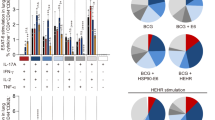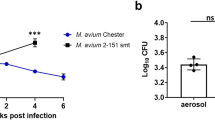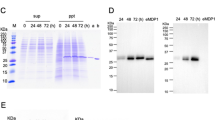Abstract
The high incidence of tuberculosis around the world and the inability of BCG to protect certain populations clearly indicate that an improved vaccine against tuberculosis is needed. A single antigen, the mycobacterial heat shock protein hsp65, is sufficient to protect BALB/c mice against challenge infection when administered as DNA vaccine in a three-dose-based schedule. In order to simplify the vaccination schedule, we coencapsulated hsp65-DNA and trehalose dimicolate (TDM) into biodegradable poly(DL-lactide-co-glycolide) (PLGA) microspheres. BALB/c mice immunized with a single dose of DNA-hsp65/TDM-loaded microspheres produced high levels of IgG2a subtype antibody and high amounts of IFN-γ in the supernatant of spleen cell cultures. DNA-hsp65/TDM-loaded microspheres were also able to induce high IFN-γ production in bulk lung cells from challenged mice and confer protection as effective as that attained after three doses of naked DNA administration. This new formulation also allowed a ten-fold reduction in the DNA dose when compared to naked DNA. Thus, this combination of DNA vaccine and adjuvants with immunomodulatory and carrier properties holds the potential for an improved vaccine against tuberculosis.
This is a preview of subscription content, access via your institution
Access options
Subscribe to this journal
Receive 12 print issues and online access
$259.00 per year
only $21.58 per issue
Buy this article
- Purchase on Springer Link
- Instant access to full article PDF
Prices may be subject to local taxes which are calculated during checkout






Similar content being viewed by others
References
World Health Organization. Global tuberculosis control. WHO Report 2001. Geneva, Switzerland, WHO/CDS/TB/2001.287.
Ginsberg AM . A proposed national strategy for tuberculosis vaccine development. Clin Infect Dis 2000; 30 (Suppl 3): S233-S242.
Enserink M . Driving a stake into resurgent TB. Science 2001; 293: 234-235.
Thomson J . New TB vaccine to be tested. Nat Med. 2001; 7: 1263.
Silva CL, Lowrie DB . A single mycobacterial protein (hsp65) expressed by a transgenic antigen-presenting cell vaccinates mice against tuberculosis. Immunology 1994; 82: 244–248.
Lowrie DB, Tascon RE, Colston MJ, Silva CL . Towards a DNA vaccine against tuberculosis. Vaccine 1994; 12: 1537–1540.
Lowrie DB, Silva CL, Colston MJ . Protection against tuberculosis by plasmid DNA. Vaccine 1997; 15: 834–838.
Bonato VLD, Lima VMF, Tascon RE . Identification and characterization of protective T cells in hsp65 DNA vaccinated and Mycobacterium tuberculosis infected mice. Infect Immun 1998; 66: 169–175.
Lowrie DB, Tascon RE, Bonato VLD . Therapy of tuberculosis in mice by DNA vaccination. Nature 1999; 400: 269–271.
Lima KM, Bonato VLD, Faccioli LH . Comparison of different delivery systems of vaccination for the induction of protection against tuberculosis in mice. Vaccine 2001; 19: 3518–3525.
Gregoriadis G . Genetic vaccines: strategies for optimization. Pharm Res 1998; 15: 661–669.
Lima KM, Santos SA, Santos Jr RR . DNA vaccine encoding mycobacterial hsp65 lacks protectivity when administered by gene gun (submitted).
Wang D, Robinson DR, Kwon GS, Samuel J . Encapsulation of plasmid DNA in biodegradable poly(D,L-lactic-co-glycolic acid) microspheres as a novel approach for immunogene delivery. J Control Rel 1999; 57: 9–18.
Recent advances on the use of biodegradable microparticles and nanoparticles in controlled drug delivery. Int J Pharm 1995; 116: 1–9.
Eldridge JH, Staas JK, Meulbroek JA . Biodegradable microspheres as a vaccine delivery system. Mol Immun 1991; 28: 287–294.
Lima KM, Rodrigues Jr JM . Poly-DL-lactide-co-glycolide microspheres as a controlled release antigen delivery system. Braz J Med Biol Res 1999; 32: 171–180.
Krieg AM . From bugs to drugs: therapeutic immunomodulation with oligodeoxynucleotides containing CpG sequences from bacterial DNA. Antisense Nucleic Acid Drug Dev 2001; 11: 181–188.
Bersa GS, Chatterjee D . Lipids and carbohydrates of Mycobacterium tuberculosis. In: Bloom BR (ed). Tuberculosis: Pathogenesis, Protection and Control. ASM Press: Washington, 1994, pp 285–306.
Saito R, Tanaka A, Sugiyama K . Adjuvant effect of cord factor, a mycobacterial lipid. Infect Immun 1976; 13: 766–781.
Koike M, Yoo YC, Mitobe M . Enhancing activity of mycobacterial cell-derived adjuvants on immunogenicity of recombinant human hepatitis B virus vaccine. Vaccine 1998; 16: 1982–1989.
Lima VMF, Bonato VLD, Lima KM . Role of trehalose dimycolate in recruitment of cells and modulation of production of cytokines and NO in tuberculosis. Infect Immun 2001; 69: 5305–5312.
Johansen P, Estevez F, Zurbriggen R . Towards clinical testing of a single-administration tetanus vaccine based on PLA/PLGA microspheres. Vaccine 2000; 19: 1047–1054.
Morein B, Villacrés-Eriksson M, Sjölander A, Bengtsson KL . Novel adjuvants and vaccine delivery systems. Vet Immunol Immunopathol 1996; 54: 373–384.
Klinman DM, Sechler JMG, Conover J . Contribution of cells at the site of DNA vaccination to the generation of antigen-specific immunity and memory. J Immunol 1998; 160: 2388–2392.
Akbari O, Panjwani N, Garcia S . DNA vaccination: transfection and activation of dendritic cells as key events for immunity. J Exp Med 1999; 189: 169–177.
Boyle JS, Brady JL, Lew AM . Enhanced responses to a DNA vaccine encoding a fusion antigen that is directed to sites of immune induction. Nature 1998; 392: 408–411.
Doe B, Selby M, Barnett S . Induction of cytotoxic T lymphocytes by intramuscular immunization with plasmid DNA is facilitated by bone marrow-derived cells. Proc Natl Acad Sci USA 1996; 93: 8578–8583.
Lewis DH . Controlled release of bioactive agents from lactide/glycolide polymers. In: Chasin M, Langer R (eds). Biodegradable Polymers as Drug Delivery Systems. Marcel Dekker: New York, 1990, pp 1–43.
Spargo BJ, Crowe LM, Ioneda T . Cord factor (α,α-trehalose 6-6′-dimycolate) inhibits fusion between phospholipid-vesicles. Proc Natl Acad Sci USA 1991; 88: 737–740.
Ryll R, Watanabe K, Fujiwara N . Mycobacterial cord factor, but not sulfolipid, causes depletion of NKT cells and upregulation of CD1d1 on murine macrophages. Microb Infect 2001; 3: 611–619.
Acknowledgements
The authors are grateful to Izaíra T Brandão for technical assistance. This study was supported by grants from Fundac̃ão de Amparo à Pesquisa do Estado de São Paulo (FAPESP) and Conselho Nacional de Pesquisa (CNPq).
Author information
Authors and Affiliations
Rights and permissions
About this article
Cite this article
Lima, K., Santos, S., Lima, V. et al. Single dose of a vaccine based on DNA encoding mycobacterial hsp65 protein plus TDM-loaded PLGA microspheres protects mice against a virulent strain of Mycobacterium tuberculosis. Gene Ther 10, 678–685 (2003). https://doi.org/10.1038/sj.gt.3301908
Received:
Accepted:
Published:
Issue Date:
DOI: https://doi.org/10.1038/sj.gt.3301908
Keywords
This article is cited by
-
Short noncoding DNA fragments improve the immune potency of electroporation-mediated HBV DNA vaccination
Gene Therapy (2014)
-
Development of avian influenza virus H5 DNA vaccine and MDP-1 gene of Mycobacterium bovisas genetic adjuvant
Genetic Vaccines and Therapy (2010)
-
TLR, NLR Agonists, and Other Immune Modulators as Infectious Disease Vaccine Adjuvants
Current Infectious Disease Reports (2010)
-
Leukotriene B4-loaded microspheres: a new therapeutic strategy to modulate cell activation
BMC Immunology (2008)
-
Protection against tuberculosis by a single intranasal administration of DNA-hsp65 vaccine complexed with cationic liposomes
BMC Immunology (2008)



